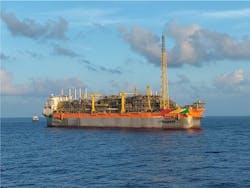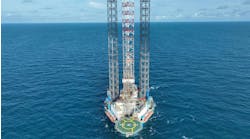The Guyana-Suriname basin is one of the hottest and most active offshore plays. At last year’s Offshore Technology Conference Mike Cousins, senior vice president of exploration and new ventures at ExxonMobil, said: “The exploration success in the basin is truly unprecedented. The discoveries in Guyana and Suriname span about 100 million years in deposition. It is an incredibly prolific basin.”
In February, ExxonMobil brought onstream Liza Phase 2, the country’s second offshore oil development. This brings total production capacity to more than 340,000 b/d in seven years since Guyana’s first discovery.
Production at the FPSO Liza Unity is expected to reach its target of 220,000 b/d of oil later this year. It adds to the more than 120,000-b/d FPSO Liza Destiny, which began production in December 2019 and is now delivering at better than design capacity.
The FPSO Liza Unity, which is moored in about 1,650 m (5,413 ft) of water and has a 2-MMbbl crude storage capacity, also features two industry firsts. The Liza Unity is SBM Offshore’s first Fast4Ward FPSO, which incorporates the company’s newbuild, multi-purpose hull combined with several standardized topsides modules. It is also the world’s first FPSO to be awarded the SUSTAIN-1 notation by ABS. This recognizes the sustainability of its design, documentation, and operational procedures.
Payara, the third project in the Stabroek block, is expected to produce about 220,000 b/d of oil using the FPSO Prosperity, which is currently under construction at Keppel Shipyard in Singapore. First topsides modules should be completed and installed in the current quarter, with first oil anticipated in 2024. The field development plan and application for environmental authorization for Yellowtail, the fourth project in the block, have been submitted for government and regulatory approval.
Exploration is heating up across other blocks offshore Guyana. CGX Energy Inc. and partner Frontera Energy Corp. discovered hydrocarbons with the Kawa-1 exploration well in the Corentyne block. The semisubmersible Maersk Discoverer drilled the Kawa-1 well that encountered about 61 m (200 ft) of hydrocarbon-bearing reservoirs within Maastrichtian, Campanian, and Santonian horizons. The Maersk Discoverer is expected to spud the Wei-1 exploration well in the northwestern part of the Corentyne block in the second half of 2022. The Canadian independents are in discussions with Guyana’s government on their other offshore concession, the Demerara block.
In May, the jackup Noble Regina Allen is expected to drill the Beebei-Potaro prospect in the Kanuku block for Repsol.
Suriname is emerging as another offshore hot spot.
Svetlana Doh, upstream oil & gas analyst at GlobalData, said the wells delivered API oil ranges from 27° to 37°, similar in fluid quality to the lighter oil produced in the Stabroek block, where wells could potentially deliver 11,000 b/d.
Taking Guyana projects as a reference, the consultant expects Suriname projects to achieve a low break-even price of around $40/bbl, higher than in Guyana, where some projects could attain $25/bbl. However, assuming that the development wells off Suriname confirm high productivities of at least 6,000 b/d and the required infrastructure is constructed, the break-even price could be much lower than $40/bbl.
GlobalData anticipates an initial capital investment for an average project in Suriname in the range $6-8 billion for recoverable reserves of around 600 MMbbl.
Doh added: “As for Suriname, the country needs to move quickly to attract as much investment and incentivize more exploration so that potential resources are not stranded, as investors prefer cleaner energy developments and increasingly scrutinize over oil and gas projects.”
TotalEnergies has exercised an option to extend the work scope of the drillship Maersk Valiant in block 58. Drilling was due to start in March and last about 100 days. The contract includes two more one-well options. The drillship Noble Gerry de Souza should have spudded a well in block 53 for APA.
As for other exploration activities offshore Suriname, TGS, CGG, and BGP are co-operating on a 3D seismic survey, using the BGP Prospector vessel. The survey covers an area adjacent to the oil-prolific block 58, and will cover up-dip portions of the same proven Upper Cretaceous channel systems. The first phase will cover around 11,000 sq km (4,247 sq mi), with data acquisition set to be completed this summer.
Finally, Chevron has signed a 30-year production-sharing contract (PSC) with Staatsolie for the 2,235-sq km (863-sq mi) block 5. While Chevron will operate the block, Staatsolie will for the first time participate as a partner in offshore activities, with a 40% interest. This will give the state-owned entity more influence in decisions and will also lead to it co-financing any potential development and production phases: Chevron will carry all costs during the six-year exploration phase. Under the PSC terms, Chevron must give preference where possible to materials, services and products offered by Surinamese companies.






